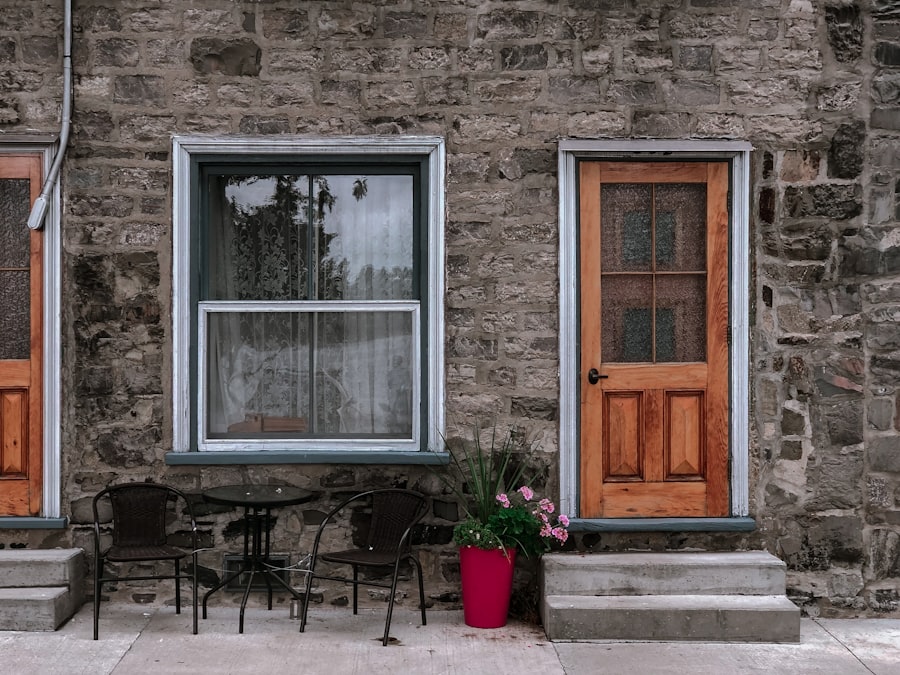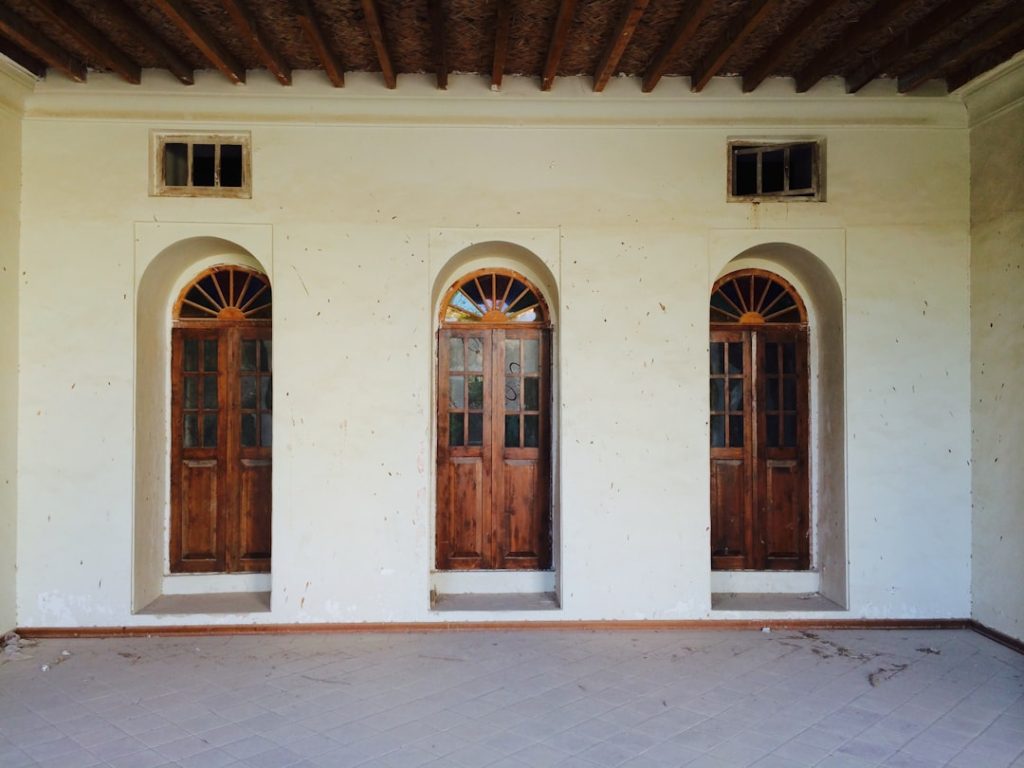The front door of a home serves as the primary entry point and is often the first impression visitors receive. A new front door can dramatically enhance curb appeal, transforming the overall aesthetic of a property. When selecting a new door, homeowners should consider materials, colors, and styles that complement the architectural design of their home.
For instance, a sleek, modern door with glass panels can provide a contemporary touch to a mid-century modern home, while a classic wooden door with intricate carvings may be more suitable for a Victorian-style residence. In addition to aesthetics, the choice of a front door can also impact functionality and security. Many modern doors come equipped with advanced locking mechanisms and materials that resist wear and tear, providing peace of mind for homeowners.
Furthermore, energy-efficient doors can help regulate indoor temperatures, reducing heating and cooling costs. For example, fiberglass doors often offer superior insulation compared to traditional wooden doors, making them an excellent choice for those looking to enhance both style and energy efficiency. By investing in a new front door, homeowners not only elevate their home’s exterior but also improve its security and energy performance.
Key Takeaways
- Installing a new front door significantly improves your home’s curb appeal.
- Adding a deck or patio creates a welcoming outdoor living area.
- Replacing windows and siding enhances energy efficiency and reduces costs.
- Exterior trim and molding add unique character and charm to your home.
- Outdoor lighting, landscaping, fencing, and gates boost security, privacy, and style.
Create an Inviting Outdoor Space with a Deck or Patio
An outdoor space that invites relaxation and social interaction can significantly enhance the enjoyment of a home. A well-designed deck or patio serves as an extension of the living area, providing a perfect setting for family gatherings, barbecues, or quiet evenings under the stars. When planning an outdoor space, homeowners should consider factors such as size, layout, and materials.
For instance, composite decking offers durability and low maintenance, while natural wood provides a warm, rustic feel that many homeowners find appealing. Incorporating features such as built-in seating, fire pits, or outdoor kitchens can further enhance the functionality of a deck or patio. These elements not only create a welcoming atmosphere but also encourage outdoor entertaining.
For example, a fire pit surrounded by comfortable seating can become the focal point of evening gatherings, while an outdoor kitchen equipped with a grill and countertop space allows for seamless meal preparation and serving. By thoughtfully designing an outdoor space, homeowners can create an inviting environment that enhances their lifestyle and increases the overall value of their property.
Boost Energy Efficiency with New Windows and Siding

Energy efficiency is a critical consideration for homeowners looking to reduce utility bills and minimize their environmental impact. One effective way to achieve this is by upgrading windows and siding. Modern windows are designed with advanced technologies such as double or triple glazing, low-emissivity (Low-E) coatings, and gas fills that significantly improve insulation.
For example, Energy Star-rated windows can reduce heat loss in winter and keep homes cooler in summer, leading to substantial savings on heating and cooling costs. Similarly, siding plays a crucial role in a home’s energy efficiency. Insulated vinyl siding or fiber cement siding can provide an additional layer of protection against the elements while enhancing the home’s exterior appearance.
These materials are not only durable but also available in various styles and colors to suit different architectural designs. By investing in new windows and siding, homeowners can create a more energy-efficient home that not only lowers utility bills but also contributes to a more sustainable future.
Add Character and Charm with Exterior Trim and Molding
| Exterior Trim Type | Material | Average Lifespan (Years) | Maintenance Level | Charm Factor | Installation Complexity |
|---|---|---|---|---|---|
| Crown Molding | Wood | 20-30 | Medium | High | Medium |
| Window Trim | PVC | 25-40 | Low | Medium | Low |
| Door Casing | Composite | 30-50 | Low | High | Medium |
| Corner Boards | Fiber Cement | 40-60 | Low | Medium | Low |
| Baseboards | Wood | 20-30 | Medium | Medium | Medium |
Exterior trim and molding are often overlooked elements that can add significant character and charm to a home’s façade. These architectural details serve both functional and aesthetic purposes, framing windows and doors while enhancing the overall design. For instance, decorative cornices or crown moldings can elevate the appearance of a simple home by adding depth and visual interest.
Similarly, window boxes filled with vibrant flowers can soften the lines of a house while providing an opportunity for seasonal decoration. The choice of materials for trim and molding is equally important. Traditional wood trim offers a classic look but requires regular maintenance to prevent rot and decay.
On the other hand, synthetic materials such as PVC or composite trim provide durability and resistance to weathering without sacrificing style. Homeowners can also explore various paint colors or finishes to further personalize their exterior trim. By thoughtfully incorporating trim and molding into their home’s design, homeowners can create a unique aesthetic that reflects their personal style while enhancing curb appeal.
Upgrade Your Home’s Exterior with a Fresh Coat of Paint
A fresh coat of paint can work wonders for a home’s exterior, breathing new life into its appearance while protecting it from the elements. Over time, exposure to sun, rain, and wind can cause paint to fade or peel, detracting from the overall look of the property. Choosing the right color is essential; neutral tones often appeal to a broad audience while bold colors can make a striking statement.
For example, a deep navy blue can lend sophistication to a coastal home, while bright yellow may evoke cheerfulness in a cottage-style residence. In addition to color selection, homeowners should consider the type of paint used for exterior applications. High-quality exterior paint is formulated to withstand harsh weather conditions and resist fading over time.
Furthermore, using primer before applying paint can enhance adhesion and longevity. Homeowners may also want to explore eco-friendly paint options that minimize harmful emissions while providing excellent coverage. By investing in a fresh coat of paint, homeowners not only improve their home’s aesthetic appeal but also protect it from potential damage caused by environmental factors.
Increase Security and Privacy with Fencing and Gates

Fencing and gates play a crucial role in enhancing both security and privacy for homeowners. A well-constructed fence not only delineates property boundaries but also acts as a deterrent against intruders. Various materials are available for fencing, including wood, vinyl, chain link, and wrought iron, each offering distinct advantages depending on the homeowner’s needs and preferences.
For instance, wooden fences provide a classic look while offering privacy; however, they require regular maintenance to prevent rot. In contrast, vinyl fencing is low-maintenance and resistant to fading but may lack the same aesthetic appeal as wood. Gates are another essential component of outdoor security.
A sturdy gate can provide controlled access to the property while enhancing its overall appearance. Homeowners may choose from various styles—such as sliding gates for smaller spaces or ornate wrought iron gates for added elegance—depending on their security needs and design preferences. Additionally, incorporating smart technology into gates can further enhance security; features such as keyless entry systems or remote access controls allow homeowners to monitor who enters their property easily.
By investing in quality fencing and gates, homeowners can create a secure environment that also enhances their outdoor living experience.
Make a Statement with Outdoor Lighting and Landscaping
Outdoor lighting plays an integral role in enhancing both safety and aesthetics in residential landscapes. Thoughtfully designed lighting can highlight architectural features of the home while illuminating pathways for safe navigation after dark. Options range from subtle landscape lighting that accentuates trees and shrubs to more dramatic fixtures that draw attention to entryways or patios.
For example, uplighting placed at the base of trees creates stunning silhouettes against the night sky while providing ambient light for outdoor gatherings. Landscaping complements outdoor lighting by creating visually appealing spaces that invite relaxation and enjoyment. Incorporating native plants into landscaping designs not only enhances beauty but also promotes sustainability by requiring less water and maintenance over time.
Features such as flower beds, rock gardens, or water features can add depth and interest to outdoor spaces while providing habitats for local wildlife. By combining strategic outdoor lighting with thoughtful landscaping choices, homeowners can create enchanting outdoor environments that extend their living space beyond the walls of their home while making a lasting impression on guests and passersby alike.




